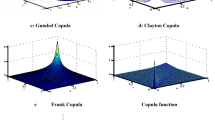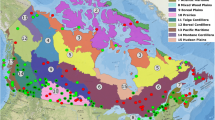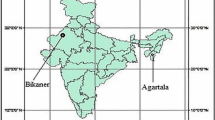Abstract
This study analyses the temperature and precipitation dependence among stations in the Mediterranean. The first station group is located in the eastern Mediterranean (EM) and includes two stations, Athens and Thessaloniki, while the western (WM) one includes Malaga and Barcelona. The data was organized in two time periods, the hot-dry period and the cold-wet one, composed of 5 months, respectively. The analysis is based on a new statistical technique in climatology: the Copula method. Firstly, the calculation of the Kendall tau correlation index showed that temperatures among stations are dependant during both time periods whereas precipitation presents dependency only between the stations located in EM or WM and only during the cold-wet period. Accordingly, the marginal distributions were calculated for each studied station, as they are further used by the copula method. Finally, several copula families, both Archimedean and Elliptical, were tested in order to choose the most appropriate one to model the relation of the studied data sets. Consequently, this study achieves to model the dependence of the main climate parameters (temperature and precipitation) with the Copula method. The Frank copula was identified as the best family to describe the joint distribution of temperature, for the majority of station groups. For precipitation, the best copula families are BB1 and Survival Gumbel. Using the probability distribution diagrams, the probability of a combination of temperature and precipitation values between stations is estimated.





Similar content being viewed by others
References
Abdi A, Hassanzadeh Y, Talatahari S, Fakheri-Fard A, Mirabbasi R (2017) Parameter estimation of copula functions using an optimization-based method. Theor Appl Climatol 129(1–2):21–32
Akaike H (2011) Akaike’s information criterion. In: Lovric M (ed) International encyclopedia of statistical science. Springer, Berlin 25p
Alpcan T, Bambos N (2009) Modeling dependencies in security risk management. In: Risks and Security of Internet and Systems (CRiSIS), 2009 Fourth International Conference on IEEE, p 113–116
Canela MA, Collazo EP (2012) Modelling dependence in Latin American markets using copula functions. J Emerg Market Finance 11(3):231–270
Cong RG, Brady M (2012) The interdependence between rainfall and temperature: copula analyses. Sci World J 12:1–11. https://doi.org/10.1100/2012/405675
Conte M, Giuffrida S, Tedesco S (1989) The Mediterranean oscillation: impact on precipitation and hydrology in Italy. In Proceedings of the Conference on Climate and Water, (1). Publications of Academy of Finland, Helsinki, p 121–137
Corte-Real J, Zhang X, Wang X (1995) Large-scale circulation regimes and surface climatic anomalies over the Mediterranean. Int J Climatol 15(10):1135–1150
Del Rio S, Fraile R, Herrero L, Penas A (2007) Analysis of recent trends in mean maximum and minimum temperatures in a region of the NW of Spain (Castilla y León). Theor Appl Climatol 90(1):1–12. https://doi.org/10.1007/s00704-006-0278-9
Dünkeloh A, Jacobeit J (2003) Circulation dynamics of Mediterranean precipitation variability 1948–98. Int J Climatol 23(15):1843–1866
Efthymiadis D, Goodess CM, Jones PD (2011) Trends in Mediterranean gridded temperature extremes and large-scale circulation influences. Nat Hazards Earth Syst Sci 11(8):2199–2214
Ekanayake EMRSB, Perera K (2014) Analysis of drought severity and duration using copulas in Anuradhapura, Sri Lanka. Br J Environ Clim Chang 4(3):312–327. https://doi.org/10.9734/BJECC/2014/14482
Feidas H, Makrogiannis T, Bora-Senta E (2004) Trend analysis of air temperature time series in Greece and their relationship with circulation using surface and satellite data: 1955–2001. Theor Appl Climatol 79(3–4):185–208
Genest C, Ghoudi K, Rivest LP (1998) “Understanding relationships using copulas,” by Edward Frees and Emiliano Valdez, January 1998. North Am Actuarial J 2(3):143–149
Genest C, Gendron M, Bourdeau-Brien M (2009) The advent of copulas in finance. Eur J Finance 15(7–8):609–618
Hertig E, Seubert S, Jacobeit J (2010) Temperature extremes in the Mediterranean area: trends in the past and assessments for the future. Nat Hazards Earth Syst Sci 10(10):2039–2050
Hofert M, Kojadinovic I, Maechler M, Yan J (2014) copula: multivariate dependence with copulas. R package version 0.999–9, URL http://CRAN.R-project.org/package=copula
Houssos EE, Lolis CJ, Bartzokas A (2008) Atmospheric circulation patterns associated with extreme precipitation amounts in Greece. Adv Geosci 17:5–11
Keerthirathne DGTC, Perera K (2015) Joint distribution of rainfall and temperature in Anuradhapura, Sri Lanka using copulas. International Research Symposium on Engineering Advancements 2015 (RSEA 2015) SAITM, Malabe, Sri Lanka, 42–45
Kioutsioukis I, Melas D, Zerefos C (2010) Statistical assessment of changes in climate extremes over Greece (1955–2002). Int J Climatol 30(11):1723–1737
Klein Tank AMG et al (2002) Daily dataset of 20th century surface air temperature and precipitation series for the European Climate Assessment. Int J Climatol 22:1441–1453 Data and metadata available at http://www.ecad.eu
Kutiel H, Maheras P (1998) Variations in the temperature regime across the Mediterranean during the last century and their relationship with circulation indices. Theor Appl Climatol 61:39–53. https://doi.org/10.1007/s007040050050
Kutiel H, Maheras P, Guika S (1996) Circulation and extreme rainfall conditions in the eastern Mediterranean during the last century. Int J Climatol 16(1):73–92
Kwak J, Kim D, Kim S, Singh VP, Kim H (2013) Hydrological drought analysis in Namhan river basin, Korea. J Hydrol Eng 19(8):05014001
Lionello P, Malanotte-Rizzoli P, Boscolo R, Alpert P, Artale V, Li L, Luterbacher J, May W, Trigo R, Tsimplis M, Ulbric U, Xoplaki E (2006) The Mediterranean climate: an overview of the main characteristics and issues. In: Lionello P, Malanotte-Rizzoli P, Boscolo R (eds) Developments in Earth & environmental sciences, Mediterranean Climate Variability, vol 4. Elsevier, Amsterdam, pp 1–26. https://doi.org/10.1016/S1571-9197(06)80003-0
Maheras P, Xoplaki E, Kutiel H (1999) Wet and dry monthly anomalies across the Mediterranean basin and their relationship with correlation, 1860–1990. Theor Appl Climatol 64:189–199
Maheras P, Flocas HA, Patrikas I, Anagnostopoulou C (2001) A 40 year objective climatology of surface cyclones in the Mediterranean region: spatial and temporal distribution. Int J Climatol 21(1):109–130
Malevergne Y, Sornette D (2003) Testing the Gaussian copula hypothesis for financial assets dependences. Quant Finan 3(4):231–250
Nelsen RB (2006) An introduction to copulas, 2nd In: Springer (eds) New York, p 269
Palutikof JP, Conte M, Casimiro Mendes J, Goodess CM, Esprito Santo F (1996) Climate and climatic change. In: Brandt CJ, Thornes JB (eds) Mediterranean desertification and land use. Wiley, New York, pp 43–86
Parker DJ, Priest SJ, Tapsell SM (2009) Understanding and enhancing the public's behavioural response to flood warning information. Meteorol Appl 16(1):103–114
Poulin A, Huard D, Favre AC, Pugin S (2007) Importance of tail dependence in bivariate frequency analysis. J Hydrol Eng 12(4):394–403
R Core Team (2016) A Language and Environment for Statistical Computing. R Foundation for Statistical Computing, Vienna see https://www.R-project.org/
Scarsini M (1984) On measures of concordance. Stochastica 8(3):201–218
Schepsmeier U, Stoeber J, Brechmann EC, Graeler B, Nagler T, Erhardt T (2012) VineCopula: statistical inference of vine copulas. R package version, 1
Schoelzel C, Friederichs P (2008) Multivariate non-normally distributed random variables in climate research—introduction to the copula approach. Nonlin Process Geophys 15(5):761–772
Schwarz G (1978) Estimating the dimension of a model. Ann Stat 6(2):461–464. https://doi.org/10.1214/aos/1176344136
Serinaldi F (2008) Analysis of inter-gauge dependence by Kendall’s τ, upper tail dependence coefficient, and 2-copulas with application to rainfall fields. Stoch Env Res Risk A 22(6):671–688
Shiau JT (2006) Fitting drought duration and severity with two-dimensional copulas. Water Resour Manag 20(5):795–815
Shiau JT, Modarres R (2009) Copula-based drought severity-duration-frequency analysis in Iran. Meteorol Appl 16(4):481–489
Sklar A (1996) Random variables, distribution functions, and copulas—a personal look backward and forward, Distributions with Fixed Marginals and Related Topics 28:1–14
Tolika K, Maheras P, Tegoulias I (2009) Extreme temperatures in Greece during 2007: could this be a “return to the future”? Geophys Res Lett 36(10)
Trigo I, Davies T, Bigg G (1999) Objective climatology of cyclones in the Mediterranean region. J Clim 12:1685–1696
Xoplaki E (2002) Climate variability over the Mediterranean. PhD thesis, University of Bern, Switzerland ([http://sinus.unibe.ch/klimet/docs/phd_xoplaki.pdf])
Xoplaki E, Gonzalez-Rouco JF, Luterbacher J, Wanner H (2003) Mediterranean summer air temperature variability and its connection to the large-scale atmospheric circulation and SSTs. Clim Dyn 20(7–8):723–739
Yang W (2010) Drought analysis under climate change by application of drought indices and copulas. MSc thesis, Civil and Environmental Engineering, Portland State University p 1–84
Yusof F, Hui-Mean F, Suhaila J, Yusof Z (2013) Characterisation of drought properties with bivariate copula analysis. Water Resour Manag 27(12):4183–4207
Zhang L, Singh VP (2007) Bivariate rainfall frequency distributions using Archimedean copulas. J Hydrol 332(1):93–109
Zscheischler J, Seneviratne SI (2017) Dependence of drivers affects risks associated with compound events. Sci Adv 3(6):e1700263
Author information
Authors and Affiliations
Corresponding author
Rights and permissions
About this article
Cite this article
Lazoglou, G., Anagnostopoulou, C. Joint distribution of temperature and precipitation in the Mediterranean, using the Copula method. Theor Appl Climatol 135, 1399–1411 (2019). https://doi.org/10.1007/s00704-018-2447-z
Received:
Accepted:
Published:
Issue Date:
DOI: https://doi.org/10.1007/s00704-018-2447-z




